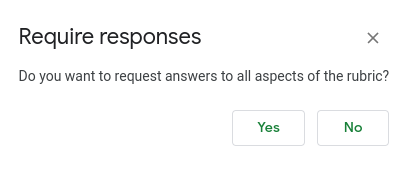 Català (Catalan)
Català (Catalan)  Español (Spanish)
Español (Spanish)
Before doing a little holidays, which at the month we are perhaps it is already time, I present a new CoRubrics functionality that I had been asked on several occasions: the possibility of not making required the qualification of all aspects of the rubric.
Until now, when CoRubrics created the form, it marked all aspects of the rubric with a required response. The reason was to prevent students (and teachers) from forgetting to grade any of them.
But it is true that there are times when it is better not to impose this obligation. Therefore, at the time of creating the form, one more question now appears.

If you choose yes, everything will continue as before. The form will be created with all the aspects required. But if you choose no, the form will be created equally but without making any required aspect.
But the difference is not only this. When calculating the averages, CoRubrics will see how many people have answered each aspect and will average it by counting only those who have rated. Until now, if someone manually asked the non-required questions, when calculating the averages a score of 0 was assigned to those who had not answered.
How useful can this functionality be? That’s how I can think of a pair.
- It is possible to create a single rubric to score among several teachers a transversal competence, like the digital one. It is very possible that not all teachers work the same dimensions, so with this functionality each one only evaluates those that have worked and have been able to evaluate.
- If we work with cooperative groups and groups of experts, it may be interesting that the rubric of the final product is not fully evaluated by all students. Perhaps each expert can evaluate his specific aspects, as he is an expert in this regard.
There is some more, some more rebound. For example, allow students to evaluate at different times. As the answer is not required, one day you qualify some aspects of the rubric and another day others. The only problem is that when processing the answers the message will appear that there are students who have scored more than once to peers and, in the results sheet, the number of scores will be higher than expected (each student will have assessed twice or more).
In any case, I hope that this new functionality can allow the evaluation of transversal competences by the whole teaching team, which is the main reason why it has been implemented. The teamwork of the teaching staff always has a good impact on students’ learning.

